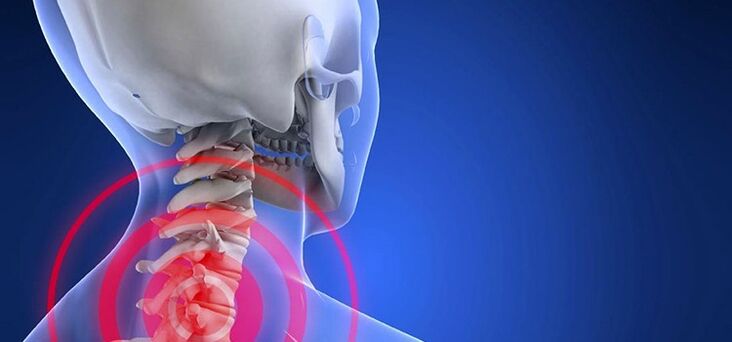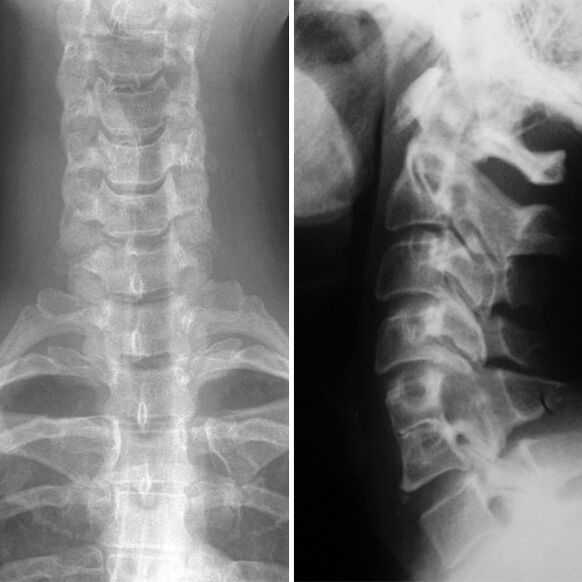
Osteochondrosis of the cervical region is one of the most common diseases of the spine, which can be explained by the high mobility of this part of the body.With the development of the disease, there is severe pain, which significantly impairs the quality of human life.That is why it is so important to consult a doctor in the first manifestations of the pathology.
Osteochondrosis Clinic of the cervical spine
The violation is progressive and consists in the appearance of dystrophic changes in the spine discs.There are seven vertebrae at this place that provide free head movements.Due to increased physical activity or insufficiently strong muscles, this spine is often subjected to such a disorder.
With the development of the disease, the metabolic processes in the spine are impaired, the strength and elasticity of the intervertebral disc disappears and the increased loads lead to the fact that cracks of the fibrous ring occur.With the development of the process, a convexity or hernia occurs.
Development
- The first degree.The disease causes few symptoms.One experiences small neck pain, increasing with turns of the head.During the examination, the doctor may identify a little muscle tension.
- The second degree.This shape is characterized by tangible pain and they can give it to the arm or shoulder.This is due to a disorder of the height of the disc, which provokes a pinch of nerves.The pain syndrome becomes more severe when the head moves.This condition is characterized by headache, increased weakness, reduction of working ability.
- The third degree.The manifestations of the anomaly increase many times, and the pain is constantly present.They can be felt not only in the neck itself, but also to affect the shoulder or arm.Hernia formation leads to weakness of the hands.One complains of chronic fatigue and dizziness.On examination, the doctor may detect a violation of neck mobility.In addition, the patient has pain during palpation.
- Fourth degree.At this stage, the intervertebral disc is completely destroyed, leading to the formation of connective tissue in its place.Also in the patient the dizziness increases significantly, the coordination of movement is impaired and there is noise in the ears.Such symptoms are a consequence of the use of the spinal artery in the pathological process - this is responsible for nutrition of the cerebellum and brain.
Reasons
Under the influence of various factors, the load on the cervical compartment increases.The muscles are trying to compensate for this process, which causes cramps and blood circulation problems.Therefore, degenerative processes occur.
The main causes of the disease are the following:
- motor activity deficiency;
- impaired metabolism;
- Improper posture;
- Excess weight;
- scoliosis;
- systematic muscle tension;
- stressful situations;
- dysplastic connective tissue abnormalities;
- Problems with the circulation in the neck;
- heredity;
- uncontrolled physical activity;
- Spinal abnormalities.
Contrary to common conception, osteochondrosis can be identified not only in the elderly.Today, such a violation is not uncommon even among children and adolescents.In addition, the number of cases of disease in humans is 18-30 years old.
Symptoms and signs of the disease
These or other symptoms of osteochondrosis are present in almost every person.If they are associated with pronounced pain, you should consult a doctor immediately.The signs of pathology include:
- Neck pain.They can give to the back of the head, shoulder, eyes or ears.Quite often they are felt during movements.Sometimes there is pain from the throbbing nature.
- Pain in the hands.The discomfort can also be felt in the area of the shoulder, the brush, the forearm, and it remains even at night.
- Violation of the activity of the hands and fingers.One can lose the sensitivity and strength of the muscles.
- Muscle tension in the morning.
- Noise in the ears.
- Headache.As a rule, they begin to feel in the back of the head, and then feel in temples and crown.
- Tingling and numbness in the limbs.
- Film, dizziness, darkening in the eyes.Such signs most often appear with careless head movements.
- Tingling of the tongue.
- Lighter hearing and vision.
- Pain in the heart area.
- Increasing the size of connective tissue in the neck.
- Disorders of sleep, memory, attention.
- Change of voice - the appearance of hoarse, weakening of the voice, etc.
Symptoms of cervical osteochondrosis
Disorders of this spine are characterized by such manifestations:
- systematic headache;
- Metostal neuralgia;
- pressure drops;
- loss of movement coordination;
- dizziness;
- chronic fatigue;
- heart pain;
- infectious pathologies;
- flickering points in front of the eyes;
- tinnitus;
- Tingling of the fingers;
- Pain in the hands and shoulders.
This form of osteochondrosis provokes many syndromes and can lead to problems with the functioning of certain organs.
For example, this pathology often provokes heart disease.Therefore, if these symptoms occur, you should consult a doctor immediately.
Syndromes
In addition to general manifestations, a number of syndromes are characteristic of cervical osteochondrosis.Thanks to these signs, it is possible to make an accurate diagnosis and choose therapy.
Korean
This condition is also often called cervical radiculitis.Rest syndrome is the result of pinching nerves in the neck.As this process progresses, the pain spreads down, reaching the shoulders.They can affect the forearms and fingers.Sometimes patients complain of guy and tingling.
The manifestations of the violation are determined by the location of the pathology.So, when the root of the central nerve is pinched, swelling occurs, which affects the large, middle and index finger.If the roots of the shoulder nerve are affected, the process touches the little finger and the ring.
Ram
This condition is characterized by severe pain that is located in the neck or nape.Often, discomfort increases after a sharp movement.As examples of such a condition, it is worth it to hurt after sleep when the patient sharply rotates his head.The discomforts can also be felt in the chest or shoulder.
Vail Arttery Syndrome
The main symptom is a headache that throbs or burn.They are often applied in the back of the head, darkness, whiskey.Also, discomfort is often felt over the eyebrows.The pain syndrome is exacerbated after a long movement.The discomfort also increases after it is uncomfortable.With a decrease in immunity, nausea, seizure, hearing problems and disorders of the vestibular apparatus are possible.Also, spinal artery syndrome often causes vision problems.Eye pain can occur.
Hearty
First of all, symptoms of angina appear.Therefore, there is a threat of unprecedented treatment of angina, instead of eliminating the main cause of discomfort.
The development of cardiac syndrome is provoked by pinching the roots of the diaphragmatic nerve or pectoral muscles.Pain with collar parts may occur, which are felt for a long time.In addition, the discomfort increases with sneezing, coughing, inaccurate head movements.
This syndrome is accompanied by tachycardia and extrasystole.In such a situation, the pain is not reduced even after the use of antianginal drugs.If you do a cardiogram during the attack, there will be no symptoms of blood circulation problems.
Complications and consequences
The most dangerous complications include:
- Spraying discs that provoke the formation of hernia.
- Disk gap with pinching nerves and blood vessels.In this condition, the spinal cord can be pulled out, which is very addicted to life.
- Radiculopathy - a disorder of nerve roots.
- The formation of osteophytes - SO - the united vertebrae spikes.As a result, paresis and paralysis are common.
Dun osteochondrosis can be a dangerous complication of this form of dupitren.
In this case, a person's tendons lose the ability to stretch.As a result, the fingers deform and cannot function properly.

Diagnostics
To diagnose a disorder, you must contact a neurologist.The specialist will prescribe such types of research:
- Radiography;
- Computed tomography;
- Magnetic resonance imaging.
In order to evaluate the condition of the cervical vessels, an ultrasound Dopplerography may be performed.For blood circulation problems, it is worth performing reoensephalography.You should also contact the optometrist, which will check the bottom of the eyes.
How to treat
To get the results you want, the treatment must be exhaustive.To do this, use medical and not -drug techniques.Doctors often prescribe medicines that help to eliminate pain and inflammation.
Be sure to accept the means to normalize cerebral circulation.If the pathology causes muscle tension, you should take relaxing agents.In addition, vitamin complexes are very useful.
An important role in the treatment of the disease is played by the effects of physiotherapy.Paraffin and electrophoresis applications are particularly useful.Water procedures, hirudotherapy, massage, acupuncture, magnetotherapy are also often prescribed.However, the most effective method of treatment is considered to be therapeutic gymnastics.In particularly difficult situations, you cannot do without surgery.
Osteochondrosis of the cervical spine belongs to the category of sufficiently dangerous disorders, as it not only causes pain, but is also able to lead to the development of serious consequences.To avoid complications, if there is any discomfort in your neck, you should seek medical attention.



































